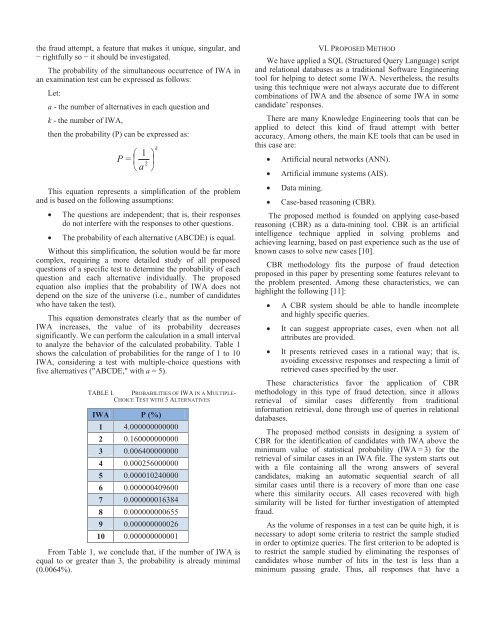Fraud Detection in Selection Exams Using Knowledge Engineering ...
Fraud Detection in Selection Exams Using Knowledge Engineering ...
Fraud Detection in Selection Exams Using Knowledge Engineering ...
Create successful ePaper yourself
Turn your PDF publications into a flip-book with our unique Google optimized e-Paper software.
the fraud attempt, a feature that makes it unique, s<strong>in</strong>gular, and<br />
− rightfully so − it should be <strong>in</strong>vestigated.<br />
The probability of the simultaneous occurrence of IWA <strong>in</strong><br />
an exam<strong>in</strong>ation test can be expressed as follows:<br />
Let:<br />
a - the number of alternatives <strong>in</strong> each question and<br />
k - the number of IWA,<br />
then the probability (P) can be expressed as:<br />
P =<br />
1 <br />
<br />
2<br />
<br />
a <br />
This equation represents a simplification of the problem<br />
and is based on the follow<strong>in</strong>g assumptions:<br />
The questions are <strong>in</strong>dependent; that is, their responses<br />
do not <strong>in</strong>terfere with the responses to other questions.<br />
The probability of each alternative (ABCDE) is equal.<br />
Without this simplification, the solution would be far more<br />
complex, requir<strong>in</strong>g a more detailed study of all proposed<br />
questions of a specific test to determ<strong>in</strong>e the probability of each<br />
question and each alternative <strong>in</strong>dividually. The proposed<br />
equation also implies that the probability of IWA does not<br />
depend on the size of the universe (i.e., number of candidates<br />
who have taken the test).<br />
This equation demonstrates clearly that as the number of<br />
IWA <strong>in</strong>creases, the value of its probability decreases<br />
significantly. We can perform the calculation <strong>in</strong> a small <strong>in</strong>terval<br />
to analyze the behavior of the calculated probability. Table 1<br />
shows the calculation of probabilities for the range of 1 to 10<br />
IWA, consider<strong>in</strong>g a test with multiple-choice questions with<br />
five alternatives ("ABCDE," with a = 5).<br />
k<br />
TABLE I. PROBABILITIES OF IWA IN A MULTIPLE-<br />
CHOICE TEST WITH 5 ALTERNATIVES<br />
IWA P (%)<br />
1 4.000000000000<br />
2 0.160000000000<br />
3 0.006400000000<br />
4 0.000256000000<br />
5 0.000010240000<br />
6 0.000000409600<br />
7 0.000000016384<br />
8 0.000000000655<br />
9 0.000000000026<br />
10 0.000000000001<br />
From Table 1, we conclude that, if the number of IWA is<br />
equal to or greater than 3, the probability is already m<strong>in</strong>imal<br />
(0.0064%).<br />
VI. PROPOSED METHOD<br />
We have applied a SQL (Structured Query Language) script<br />
and relational databases as a traditional Software Eng<strong>in</strong>eer<strong>in</strong>g<br />
tool for help<strong>in</strong>g to detect some IWA. Nevertheless, the results<br />
us<strong>in</strong>g this technique were not always accurate due to different<br />
comb<strong>in</strong>ations of IWA and the absence of some IWA <strong>in</strong> some<br />
candidate’ responses.<br />
There are many <strong>Knowledge</strong> Eng<strong>in</strong>eer<strong>in</strong>g tools that can be<br />
applied to detect this k<strong>in</strong>d of fraud attempt with better<br />
accuracy. Among others, the ma<strong>in</strong> KE tools that can be used <strong>in</strong><br />
this case are:<br />
Artificial neural networks (ANN).<br />
Artificial immune systems (AIS).<br />
Data m<strong>in</strong><strong>in</strong>g.<br />
Case-based reason<strong>in</strong>g (CBR).<br />
The proposed method is founded on apply<strong>in</strong>g case-based<br />
reason<strong>in</strong>g (CBR) as a data-m<strong>in</strong><strong>in</strong>g tool. CBR is an artificial<br />
<strong>in</strong>telligence technique applied <strong>in</strong> solv<strong>in</strong>g problems and<br />
achiev<strong>in</strong>g learn<strong>in</strong>g, based on past experience such as the use of<br />
known cases to solve new cases [10].<br />
CBR methodology fits the purpose of fraud detection<br />
proposed <strong>in</strong> this paper by present<strong>in</strong>g some features relevant to<br />
the problem presented. Among these characteristics, we can<br />
highlight the follow<strong>in</strong>g [11]:<br />
A CBR system should be able to handle <strong>in</strong>complete<br />
and highly specific queries.<br />
It can suggest appropriate cases, even when not all<br />
attributes are provided.<br />
It presents retrieved cases <strong>in</strong> a rational way; that is,<br />
avoid<strong>in</strong>g excessive responses and respect<strong>in</strong>g a limit of<br />
retrieved cases specified by the user.<br />
These characteristics favor the application of CBR<br />
methodology <strong>in</strong> this type of fraud detection, s<strong>in</strong>ce it allows<br />
retrieval of similar cases differently from traditional<br />
<strong>in</strong>formation retrieval, done through use of queries <strong>in</strong> relational<br />
databases.<br />
The proposed method consists <strong>in</strong> design<strong>in</strong>g a system of<br />
CBR for the identification of candidates with IWA above the<br />
m<strong>in</strong>imum value of statistical probability (IWA = 3) for the<br />
retrieval of similar cases <strong>in</strong> an IWA file. The system starts out<br />
with a file conta<strong>in</strong><strong>in</strong>g all the wrong answers of several<br />
candidates, mak<strong>in</strong>g an automatic sequential search of all<br />
similar cases until there is a recovery of more than one case<br />
where this similarity occurs. All cases recovered with high<br />
similarity will be listed for further <strong>in</strong>vestigation of attempted<br />
fraud.<br />
As the volume of responses <strong>in</strong> a test can be quite high, it is<br />
necessary to adopt some criteria to restrict the sample studied<br />
<strong>in</strong> order to optimize queries. The first criterion to be adopted is<br />
to restrict the sample studied by elim<strong>in</strong>at<strong>in</strong>g the responses of<br />
candidates whose number of hits <strong>in</strong> the test is less than a<br />
m<strong>in</strong>imum pass<strong>in</strong>g grade. Thus, all responses that have a
















